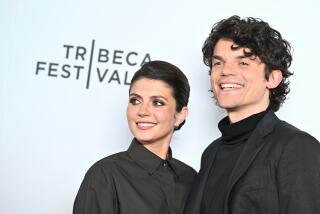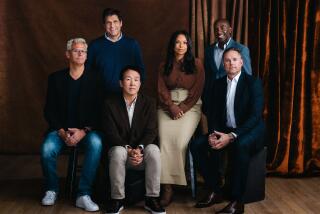Putting Power Into Viewersâ Fingertips?
Television viewers have often been depicted as passive and solitary, numbly absorbing what spills from the tube into their living rooms. Even ABC lampoons that âcouch potatoâ image with slogans like âDonât just sit there. OK, just sit thereâ as part of its cheeky ad campaign.
The Internet, however, is helping to showcase another segment of the TV audience, consisting of people who are surprisingly passionate about the programs they watch, using computers to instantly register opinions and forge bonds with like-minded fans.
Though online followings have played a role in the success of such shows as âThe X-Filesâ and âXena: Warrior Princess,â providing a venue for hard-core followers to debate minute nuances and drool over the stars, the Internetâs most profound influence could be in its ability to rapidly mobilize supporters of low-rated and canceled series.
In recent months, online groups have launched well-organized media-savvy campaigns on behalf of such programs as âDr. Quinn, Medicine Woman,â âThe Magnificent Sevenâ and âPrey,â an ABC sci-fi drama that ranks a mere No. 127 among the 157 prime-time series broadcast since last September.
More than two months after âDr. Quinnâsâ cancellation by CBS, its proponents persist in taking their case to the networkâs affiliates, advertisers, other networks and the press, hoping to keep the series alive while challenging CBSâ rationale in dropping it.
Those backing âThe Magnificent Sevenâ--which CBS has since renewed for next year--raised thousands of dollars through individual contributions to place ads in the Hollywood trade papers, hand-delivering copies to network executives. âPreyâ organizers have done the same under their âPREY for Usâ theme, in addition to distributing promotional packets to various networks urging them to buy the show once ABC passed, contacting major-market newspapers and producing items like âPreyâ bumper stickers and T-shirts.
Elizabeth Bird, an anthropology professor at the University of South Florida, has monitored a âDr. Quinnâ online group for roughly two years and has been especially struck by the close-knit community thatâs formed.
âThey can swing into action almost immediately,â she said. âThat can happen very quickly in a very organized way. . . . It contradicts many of the common stereotypes of television watchers.â
Bird added that many fans use the show as a jumping-off point for detailed exploration of broader issues, functioning like an electronically joined book club or literary club. The nature of that interaction, she said, takes on a life that extends beyond the show itself and is âa long, long way from the image of the crazed fan who sits all day at the computer and doesnât really have a life.â
In general, television programmers havenât put much stock in such online followings. A successful television program, they note, must attract millions and millions of viewers, so inspiring loyalty among a few thousand people--no matter how rabid--isnât enough alone to make a program commercially viable.
For the networks, Bird said, âtheyâre easy to dismiss. Theyâre seen as unrepresentative, in that they are so much more involved than the average viewer is.â
Even so, as network ratings dwindle and cable channels focus on siphoning off narrow slices of the audience, such groups become increasingly difficult to tune out, in part because of the technology at their disposal.
Gina Evers has spearheaded the âPreyâ push, coordinating the showâs far-flung supporters using nothing more than her $1,500 computer.
The 42-year-old Ocala, Fla., educator stresses, as do many other online fans, that she is new to this sort of activism, having been captivated by the show. Evers says she watches only four or five hours of television a week, making her the sort of sporadic viewer networks struggle to reach, and describes her cohorts as âreally discerning TV viewers who want to make sure their voices get heard.â
Realizing that âPreyâ backers face long odds in championing such a little-seen show, Evers--having taken the equivalent of a crash course in the business of television--contends that the high failure rate of new series (roughly one-fifth of new shows survive to see a second year) suggests that broadcasters ignore such messages at their own peril.
âI know they may not be listening to me, but common sense tells me if youâre failing with 80% or 85% of your products, somethingâs wrong. Youâre going to go broke,â she said.
âIf you get a group of people together who are this enthusiastic about a product, if weâre willing to do this, we must represent other people out there [who arenât being as vocal about it]. I think you should say, âHmm. Maybe we should take a look at a product that can enthuse people that much.â â
Upset by CBSâ stated reasons for axing âDr. Quinnâ (that the showâs audience was âtoo old and too femaleâ), that showâs loyalists have pleaded their case directly to advertisers and the networkâs affiliated stations. Some Web sites even offer a guide on how to compose such letters, with details like providing age and income level--factors that networks and media buyers consider in determining a programâs commercial worth.
Kelly Kahl, CBSâ senior vice president of scheduling, said the e-mail regarding âDr. Quinnâ is âby and large well-reasonedâ and often very emotional. Unfortunately, he said, the network has no way of putting a price on such ardor, and ultimately âthe ad dollars [a network can charge] arenât set by the number of letters we get.â
*
No one is certain when small but impassioned audiences will be enough to sustain programs. Pay-per-view technology could theoretically allow viewers to pony up for the privilege of seeing a favorite show, but officials say they have yet to reach that stage.
Even in failure, these campaigns offer a sense of satisfaction to producers whose work once would have sunk more quietly into the prime-time quagmire.
William Schmidt, who created âPreyâ but was removed from the show after a creative dispute with the studio, said heâs pleased to discover the concept âobviously captured some peopleâs imaginationâ despite the low ratings.
âItâs the only really nice thing thatâs come out of it,â he said. âWhen I got into this business itâs because I was sitting at home in a small mill town outside Pittsburgh, watching âBonanzaâ and being entertained. Itâs nice to know that happened even for those 3 [million] or 4 million people.â
Florida professor Bird acknowledged that the nature of online groups invites discussion of larger issues, among them whether ties forged via the Internet have flourished because of a lack of such connections through more traditional activities; still, whatever inspires these relationships, they are clearly significant to those involved.
âThis community is working together, with trust and confidence in each other,â Bird said of those amassed behind âDr. Quinn.â âI think thatâs kind of impressive, no matter what [objective] itâs aimed at. . . . It does sort of indicate television isnât quite the vast wasteland itâs made out to be. There is potential there.â
More to Read
The biggest entertainment stories
Get our big stories about Hollywood, film, television, music, arts, culture and more right in your inbox as soon as they publish.
You may occasionally receive promotional content from the Los Angeles Times.










